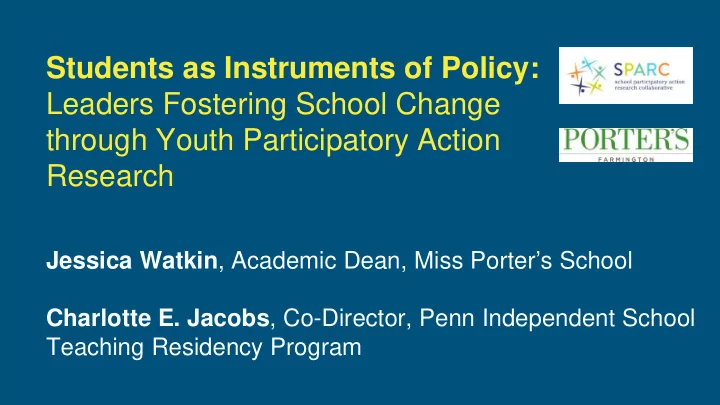

Students as Instruments of Policy: Leaders Fostering School Change through Youth Participatory Action Research Jessica Watkin , Academic Dean, Miss Porter’s School Charlotte E. Jacobs , Co-Director, Penn Independent School Teaching Residency Program
Miss Porter’s School Miss Porter's School educates young women to become informed, bold, resourceful, ethical global citizens. We expect our graduates to shape a changing world.
SPARC: Research Grounded in Youth Participatory Action Research (YPAR) “In collaboration with the University of Pennsylvania, teachers and students at member schools conduct participatory action research so that student voices inform institutional policies…” - SPARC Mission Statement https://sparc-csbgl.org/
School Participatory Action Research Collaborative (SPARC) SPARC is a research consortium among faculty and students at the University of Pennsylvania’s Graduate School of Education and school leaders, faculty and students at a cohort of leading independent schools. The purpose of the collaboration is to systematically mobilize student insights and voices to improve school culture, policy and practice.
Taking Stock of School Climate: Comprehensive Assessment of Student Life (CASL) ● Completed by SPARC member schools every other year ● All students in grades 9-12 complete the 70-item survey ● Examines 6 factors of school life: Citizenship & Student Voice ○ Social Environment ○ Faculty Support of Students (Academic & Social) ○ Peer Culture & Student Self-Confidence ○ Students’ Emotional Well-Being ○ ○ Students’ Academic Self-Perception
Turn and Talk What are conversations in your school community that you’re currently having or need to have connected to the “hidden curriculum” of your school? In a few minutes we will share with the group.
Research Methods at Porter’s
History of Research Projects 2010-2011: Students’ and Ancients’ perceptions of their preparation for co-ed college and life experiences 2011-2012: Students’ academic self-perception 2012-2014: Students’ perceptions of their own and their peers’ SES and the impact on relationships 2014-2015: Students’ definitions of success and achievement 2015-2017: Black and white students’ perceptions of teacher support, feedback, and the classroom environment 2017-2019: Asian and Asian-American students’ sense of belonging at school
2010-2011: Preparation for a Co-Ed World
2010-2011: Preparation for a Co-Ed World “ The ‘strange creatures’ in my college classes were not the boys, but the girls who didn’t talk. Why was I the only girl raising her hand? ” Social = Boys Negative Impact Social = Everyone Positive Impact More contact with young Ancients!
2010-2011: Preparation for a Co-Ed World Team Ancient: ● Alumnae & Development ● College Counseling Team Boy: ● Board of Trustees of Avon Old Farms ● Dean of Students Office
2012-2014: Socioeconomic Status Findings: ● Middle class desire ● Ways school perpetuates the socio-economic divide
2012-2014: Socioeconomic Status ● Presented to Board of Trustees ● Shared results with Administrative Teams ● Met with CFO and Business Office staff ● Changed structure of ring prices
2012-2014: Socioeconomic Status Students Parents “My daughter is not concerned with economic status.” “Our daughter never discusses this with us. This is not something we believe she thinks about.”
2015-2016: Structures at School Quick survey sent out to the student body during Advisory: “What structures positively influence your feelings of • success at school?” “What structures negatively influence your feelings of • success at school?”
2015-2016: Structures at School Findings and Action Awards Assembly • Academic Schedule • Required Meetings and Assemblies • Official Notes •
2015-2016: Structures at School Next Research Question • What are students’ experiences with Official Notes? Action • New system of Student-Teacher Dialogues and return to end-of-semester comments
2016-2017: Raced Structures? ● Are there differences in the content of Black and African- Faculty Support of Students American students’ versus White students’ Official Notes? ● Artifact Analysis of 3.5 years of Official Notes for 8 students - no race-based differences in feedback
2016-2017: Raced Structures? Major finding: the centrality of teachers ● Allowing certain students to opt out ● Silence for fear of “getting it wrong” or “being policed” ● “Color-blind” orientation isn’t helpful ● Not the job of the Black students to teach about race
2016-2017: Raced Structures? Research-Based Plan Present to Committee on Equity and Inclusion • Present to adult community followed by break-out groups • Establish classroom norms across the school • Share results with outside facilitators •
Turn and Talk What opportunities are there to bring in student voice and leadership with the goal of change in school culture in a meaningful way in your school? In a few minutes we will share with the group.
Community Life Team ● Committee Membership: Shift over 5 years from large administrative committee to one student representative, to five students and five adults. ● Senior and New Girl Interviews: Shift from departments “reading for their names” to deliberate coding for themes ● Action: Shift from adult confirmation bias and individual feedback to student-initiated prioritizing, planning, and action
NEASC Accreditation ● Two seniors appointed to lead the Standard 5 process. ● Student-designed faculty “Speed-Date” data collection device - important source of data for Standard 9 - Faculty and Standard 4 - Program. ● Students part of St. Paul’s School Visiting Committee - Spring 2018 and subsequent follow-up with CIS .
Impact FOR Students ● Agency, Belonging, Competence (Mitra, 2003) ● Emotional support with confronting biases and with hearing and holding sensitive information
Feedback Please! Rate this session in the 2019 NAIS Annual Conference Mobile App. Go to the workshop listing and click on the Clipboard icon to the left of the event description to provide valuable feedback on the workshop that you just attended.
Recommend
More recommend